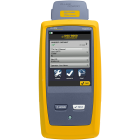Cable Labeling Best Practices, Circa 2017
August 23, 2017 / Standard and Certification
For professional contractors and installers of data communications cabling systems, compliance with ANSI/TIA 606-B Standards updated back in 2012 has required new levels of precision in cable labeling – often an arduous and time-consuming process for cable installers. Today, however, thanks to smart, cutting-edge cable labeling tools and technologies, that situation has improved dramatically!
606-B Compliance…and a Whole Lot More
The expanded 606-B Standard classifies installations based on scope and complexity, and the published guidelines provide proper identification and labeling protocols for all infrastructure components, including: individual and bundled wire and cables, faceplates, patch panels, cabinets, racks, and other electrical and electronic hardware.
The Standard also calls for:
- Text and numeric codes on labels to be machine-generated, fully visible and legible, with all cables and pathways labeled at both ends for ease of tracking and tracing.
- Label printing to be smear-resistant, abrasion-resistant, and able to withstand moisture, humidity, UV light, chemicals and solvents, and extremes of heat and cold.
- Labels to meet UL969 specifications for legibility, defacement and adhesion, and offer a design life equal to or greater than that of the labeled components.
- The installation to be tested and fully documented to facilitate system upgrades and simplify troubleshooting, repairs, and future moves, adds and changes (MACs).
The ANSI/TIA 606-B updates were passed to ensure that the label ID and marking system would deliver the same long service life as the network itself.
Mobile cable labeling tools have advanced tremendously in the five years since the standard was approved. That’s because industry-leading hardware and software firms have stepped up to provide affordable, high-volume, industrial label printing solutions that can speed up project workflows while increasing quality, accuracy and 606-B compliance. Two examples of these newer, technology-driven products are Brother’s PT-E550W and PT-E110.
Following are a few “Best Practices, Circa 2017” for sourcing and implementing next-gen cable labeling solutions that make it faster and easier for contractors and installation work crews to comply with ANSI/TIA 606-B guidelines, no matter the project size and scope.
Select a Next-Generation Industrial Labeling Tool.
Look for:
- Compact, reliable and versatile handheld thermal labelers incorporating smart technology, intuitive navigation and broad functionality for ease of use and comfortable operation throughout the work shift.
- Built-in Wi-Fi, WLAN, Bluetooth and NFC capabilities, built-in label design templates for 606-B compliant short- and long-format labels, using advanced Alpha and numeric serializing.
- Built-in software apps that turn every worker’s smartphone or tablet into a powerful print engine, able to design and print directly from virtually any smart device and operating system, and even download preformatted labels from networked databases.
Specify Rugged, Industrial-Grade Laminated Labels.
- Only tough, long-lasting labels printed and cut from industrial-grade tape cassettes can stand up to the rigors of installations in which individual and bundled wires and cables are pulled from point-to-point, often through conduits and raceways in ceilings, floors and other out-of-the-way space.
- Selecting UL-approved polyester laminated label tapes ensures long-term integrity, legibility and adhesion by encapsulating the print between two protective layers which, in turn, resist abrasion, smearing and other damage from chemicals, moisture, humidity or extreme temperatures.
Test, Document and Record the Installation.
- Contractors should create a detailed, accurate, leave-behind record of the original installation and test results. One way to save labor by automating this process is Brother’s iLink&Label™ app, which uses Fluke Networks’ Versiv tester and LinkWare Live to centralize and store documented cable labeling and test data securely in the cloud.
- Documentation should be updated as needed by system administrators to reflect any subsequent changes. This lowers the cost of ownership and maintenance and provides an accurate blueprint to follow should the configuration ever need to be re-created due to damage or destruction from fire, flood or other disaster. It also ensures quality assurance, audit compliance and certification required by manufacturer and installer warranty terms.
Craig Robinson, RCDD
Director of Sales , Brother Mobile Solutions
Craig Robinson manages growth strategy, channel, and business development initiatives for the Brother P-touch EDGE® brand of products. Craig joined Brother Mobile Solutions in 2010 to oversee the expansion of its industrial labeling products division and further integrate the P-touch EDGE line of products into datacom, electrical, high voltage, security, AV and other key markets. Under his direction, EDGE has become a respected, market leading brand in the industrial labeling space. Based in Southwest, Florida, Craig is a thought leader in the Brother organization and veteran of the telecommunications industry with over 20 years’ experience designing, implementing, and selling structured cabling solutions.







